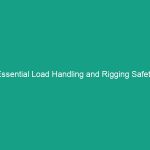Good Morning Team!
Today, we’re diving into an essential topic that affects each one of us: Must-Know Safe Lifting Practices. Lifting may seem like a simple task, but improper techniques can lead to serious injuries, affecting not only your health but also our team’s productivity. Let’s explore why these practices are crucial for our Safety and well-being on the job.
Understanding Safe Lifting Practices
Safe lifting practices refer to the guidelines and techniques designed to minimize the risk of injury while lifting heavy objects. These practices are vital in ensuring that employees can perform their duties without putting themselves at risk for strains, sprains, or more severe injuries. Every day, many of us lift boxes, tools, or equipment, and understanding the correct way to do this is essential for maintaining a safe workplace.
Common misconceptions include the belief that lifting heavier objects is merely about strength. In reality, it’s about technique. Using proper Lifting Methods can significantly reduce the strain on your body, particularly your back, which is often the most affected area during improper lifting.
Key Hazards, Risks, and Safety Considerations
When lifting improperly, you expose yourself to various Hazards, including:
- Back Injuries: The most common injury resulting from lifting is back pain, which can be acute or chronic.
- Muscle Strains: Improper technique can lead to muscle strains in the arms, shoulders, and legs.
- Falls: Lifting while walking or turning can lead to loss of balance and falls.
- Long-term Damage: Repeated improper lifting can lead to long-term musculoskeletal disorders.
Ignoring safe lifting practices can result in significant consequences—not just for you personally, but also for team dynamics and productivity. Injuries can lead to missed workdays, decreased morale, and increased costs for medical care and insurance.
Best Practices, Procedures, & Actionable Advice
Here are some straightforward steps and tips to ensure safe lifting:
1. Assess the Load
Before lifting, evaluate the weight and shape of the object. If it’s too heavy or awkward, ask for help or use equipment such as dollies or forklifts.
2. Plan Your Route
Ensure the path you will take is clear. Remove any obstacles that could cause you to trip or fall while carrying the load.
3. Use Proper Techniques
Follow these lifting techniques:
- Stand close to the object with your feet shoulder-width apart.
- Bend at your hips and knees, not your back.
- Keep your back straight and your head up.
- Get a firm grip on the object with both hands.
- Lift with your legs, not your back, and keep the load close to your body.
- Pivot your feet to change direction, rather than twisting your back.
- Lower the object by bending your legs, not your back.
4. Take Breaks
If you are lifting repeatedly, take regular breaks to avoid fatigue. Fatigue can lead to careless lifting and increase the risk of injury.
5. Use Mechanical Aids
Whenever possible, utilize tools such as forklifts, hoists, or hand trucks to assist with lifting heavy items. This can greatly reduce the physical strain on your body.
Real-World Example
Consider a scenario where an employee ignored safe lifting practices while moving boxes of supplies. They lifted a heavy box without bending their knees and ended up straining their back, leading to weeks of recovery and missed work. This incident not only affected their health but also the team’s productivity, as tasks were delayed while they were out. By following safe lifting techniques, this situation could have been avoided.
Regulations, Standards, and Compliance
Adhering to safety Regulations, such as those set forth by OSHA (Occupational Safety and Health Administration), is critical. osha provides guidelines that emphasize the importance of safe lifting practices and the proper use of equipment. Compliance with these Standards not only protects employees but also ensures that the company avoids legal liabilities and maintains a safe work Environment.
Remember, safety is a shared responsibility. When we all follow these guidelines, we contribute to a healthier workplace.
Employee Engagement & Discussion
Now, I’d like to open the floor for discussion. Think about your experiences:
- What safety challenges have you encountered related to lifting?
- Have you ever witnessed someone getting injured due to improper lifting techniques?
- What solutions or tools do you think could improve our lifting practices?
Your input is valuable, and sharing your experiences can help us all learn and improve our safety protocols.
Conclusion & Key Takeaways
In conclusion, understanding and implementing safe lifting practices is crucial for our health and safety at work. By following the guidelines we discussed today, we can significantly reduce the risk of injury and create a safer work environment for everyone.
Let’s commit to prioritizing these practices in our daily routines. Remember, your health is your greatest asset. Thank you all for your attention and dedication to maintaining a safe workplace. Together, we can make a difference!


